Art History Exam 2
1/47
There's no tags or description
Looks like no tags are added yet.
Name | Mastery | Learn | Test | Matching | Spaced |
|---|
No study sessions yet.
48 Terms
still life is a work of art depicting inanimate subject matter, typically commonplace objects which are either natural (food, flowers, rocks) or man-made (drinking glasses, books, jewelry). A visual analogy is a representation of a concept or relationship using visual means, where an image is used to explain or draw a parallel to something else
Images can be read and quoted. Can also have analogies and metaphors
a philosophy that represents subjects as a perfect or idealized version of reality, rather than showing the harshness of the real world. It emphasizes perfection and beauty
What is verism?
an artistic style that emphasizes extreme realism, often portraying subjects with a high degree of truthfulness by focusing on their imperfections and unique features, such as wrinkles, scars, and other signs of age or experience
What is a tumulus (plural tumuli)?
Etruscan burial mound
The inside is carved in relief to aide the dead into the afterlife
How did Hellenistic artists represent the psyche? Is psychological intensity a characteristic of Hellenistic art?
Yes, psychological intensity is a definitive and major characteristic of Hellenistic art, marking a significant departure from the restrained idealism of the Classical period.
Hellenistic artists represented the psyche (soul or self) by focusing on individual human emotion, realism, and dramatic expression to evoke powerful feelings and self-reflection in the viewer
How is the soul represented in various forms of art? How do you use the body to represent the soul? What about animals?
embodied art
A representation of a character embodied by someone else
Actual human (or animal) bodies that are images, like theatre
What are the characteristic features of the different styles of Roman art?(1st-4th styles) style?
1st: Incrustation
the imitation of costly marble veneer using painted panels and stucco moldings. The goal was to make the wall look as if it were constructed of luxurious, imported colored stone blocks, without the actual expense
2nd: Architectural
rejected the flat appearance of the First Style in favor of creating an illusion of depth and space. Artists used linear perspective to "break open" the wall, making the room feel larger by depicting architectural elements, such as columns, windows, and entire buildings.
3rd: Ornate
marked a return to the flat wall surface, rejecting the grand illusionism of the Second Style. The focus shifted to sophisticated, delicate ornamentation with a more monochromatic background.
4th: Intricate
combined elements from all previous styles, resulting in the most complex and busy compositions. It revived large-scale narrative painting and panoramic vistas while retaining the ornamental quality of the Third Style.
What does the imagery of Marcus Aurelius teach us about clemency? What is clemency?
clemency is a reasoned and virtuous act of the mind, not a reactive emotional response. Clemency is the power to show mercy, particularly to those who have wronged you. Aurelius's philosophy shows that clemency comes from a place of understanding, self-control, and the recognition that all people are connected, rather than from weakness or a desire for revenge.
What are the various ways that Roman artworks could animate beliefs? What role did materials play in these animations? What role does sensory experience play?
Roman artworks animated beliefs by providing tangible, physical representations of the divine and mythological narratives, facilitating a direct connection between mortals and the gods. The strategic use of materials and the deliberate creation of multi-sensory experiences made religious figures and stories feel immediate, real, and accessible to the Roman populace.
Similarities and differences between Etruscan, Greek, and Jewish temples
Differences
Etruscan temples use more wood columns and tile timber roofs, while Greek and Jewish temples use more stone
Etruscan temple walls are made of sun-dried mud brick, while Greek and Jewish temples use stone
Both Etruscan and Greek temples use light Greek stone
Similarities
All temples were built for religious purposes
Why the Arch of Titus was constructed
Depicting the Babylonians bringing the arc of the covenant into Rome
Built after Titus died
built to commemorate the Roman triumph in the Jewish War and to honor the military victories of Emperors Vespasian and Titus, particularly the capture of Jerusalem in 70 CE. Constructed around 81 CE by Emperor Domitian, Titus's brother and successor, the arch served as a permanent symbol of this imperial triumph. Its reliefs, featuring the spoils of the Jerusalem Temple like the menorah
The rights that women did and didn’t have in Etruscan culture
Had more rights than other women of ancient cultures
Very literate
Did play sports, but not with men
What features and elements characterized Etruscan art and sculpture
vitality and movement, a blend of Greek and Near Eastern influences adapted to local customs (especially funerary beliefs), and the prominent use of terracotta and bronze as primary materials.
Greek, Roman, and Etruscan beliefs about marriage and life after death
Greek: marriage seen as earthly contract, afterlife was scary, no focus on eternal marriage
Roman: marriage seen as contract, with objects leading to the afterlife, but no real focus on eternal marriage
Etruscan: Marriage was joyful, elevated women’s rights, eternal marriage with joy continuing into the afterlife
What artistic ideas/terms we have discussed are present on the sardonyx cup depicting medusa’s head
animation
Movement
characterized by gold backgrounds, a shift from naturalism to symbolic representation, the use of vibrant glass tesserae, and a focus on Christian religious themes
Etruscan terms
Chryselephantine - Ivory and gold
Peristyle - Columns going all the way around
Phenomenology - Sensory experience of the artwork
False Door - A painted door for the deceased.
Tumuli - What the mounds were called
idealized nude male form, balanced asymmetry through a contrapposto stance, and a depiction of a moment of transition or incipient movement. Created by Polykleitos, it represents an ideal of physical perfection and is a visual embodiment of his theoretical "Canon" for human proportions, with a relaxed leg and arm contrasted by a tensed leg and arm, and a slight tilt of the head for balance.
ancient Roman art, specifically frescoes in the Second Style. The frescoes are renowned for their vivid, life-sized depictions of what is believed to be an initiation into a cult of Dionysus and are a masterpiece of ancient painting.
more focused on real, specific people, still style
Shows how these people truly are (realism, verism?)
In the Jewish temples they had more symbolic objects rather then realistic images. The menorah was reference the tree of life. Some of the actual images are the cherubims on the veil and the ark. There was a lot of phenomenally with the lighting, incense, sacrifice, etc.
but they never depicted deity inside of the temple like the Greeks and Romans
Cult Image's - They didn't have images of the divine. The closest images that they had were the cherubim on the veil and the ark of the covenant.
Figural Art - is art that represent figures or objects. There wasn't a lot in Jewish culture since they believed God should not be depicted and no worshipping images.
Abstract Images - Materials represent people or objects. It was all about symbolism. The colors they used also represented the elements. (like the priest's colorful garments) Phenomenology with lighting and incense was also abstract.
Performative Images - Representing something through movement and or sound. (They believed that God could dwell in an object.)
Moses’ Tabernacle
portable temple
outer court, holy place, holy of holies
Represented God dwelling among the Israelites as they journeyed, with the progression through its sacred spaces symbolizing a spiritual journey of moving from the mundane world to the presence of God.
Solomon’s Temple
A permanent structure built by King Solomon on Mount Moriah, replacing the Tabernacle. It was a larger, more elaborate stone building with a similar layout: the porch, the Holy Place, and the Holy of Holies. Notable additions included the two large bronze pillars, Jachin and Boaz, at the entrance. It was destroyed by the Babylonians in 587/586 BCE
The Molten Sea
After this was destroyed, the molten sea and the ark of the covenant were lost
Herod’s Temple:
A massive renovation and expansion of the Second Temple (built after the first was destroyed) by King Herod. Herod's project was a multi-generational effort that enlarged the temple courts significantly to accommodate large pilgrimage crowds. This renovation was the third and final temple built on the site. It was destroyed by the Romans in 70 CE.
a "synagogue" is a general term for a Jewish house of worship used for prayer, study, and community gatherings, while "Temple" historically refers to the single, central, and sacred structure in Jerusalem that was destroyed twice
There were men in those dark ages who could commune with God, and who, by the power of faith, could draw aside the curtain of eternity and gaze upon the invisible world. There were men who could tell the destiny of the human family, and the events which would transpire throughout every subsequent period of time until the final winding-up scene. There were men who could gaze upon the face of God, have the ministering of angels, and unfold the future destinies of the world. If those were dark ages I pray God to give me a little darkness
The term "Late Antiquity" conveys a different idea than the "Dark Ages" because it emphasizes historical continuity and gradual transformation, while "Dark Ages" implies a period of abrupt collapse, ignorance, and a lack of records. Modern historians widely prefer "Late Antiquity" as a more neutral and accurate description of a complex era that saw significant cultural and religious shifts, not a total societal breakdown.
Byzantine art didn't strive for naturalism it was more about symbolism. They used perspective from the classical age to shift and warp images. They would put people or objects in the background and the foreground at the same time.
The types of static images are;
After Image - Showing the result of the change but you would need to know the story before hand. (Like just a tree or animal that used to be a person)
Before and After - two images to show the change. (the Lycurgus Cup)
Change in process - Multiple images depicting the parts of the transformation. (think of the vase where Dionysus changed the sailors into dolphins)
Changes in material Appearance - When the material reflects the story and or change (Lycurgus cup)
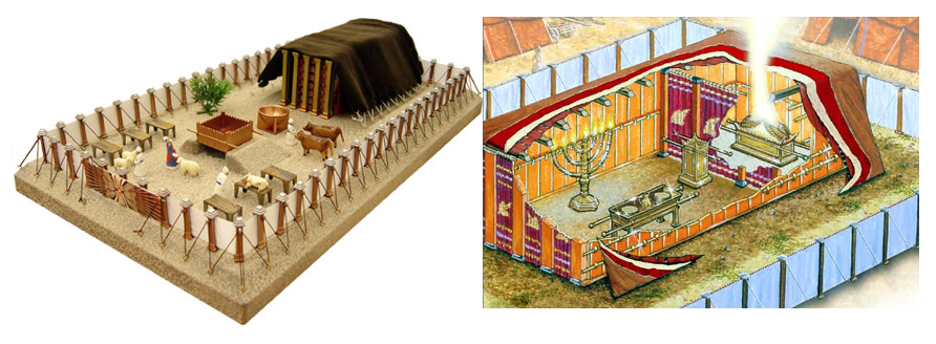
Moses' Tabernacle, c. 1350-1150 BCE, Sinai wilderness and the Levant.
So what?
portable
Outer courtyard (animal sacrifices), holy place (incense, menorah, only the priest), holy of holies (ark of the covenant, only the high priest)
Moses received revelation
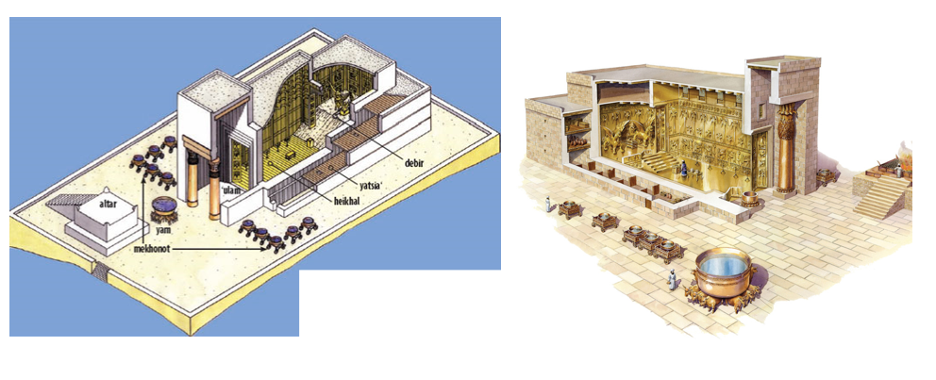
Solomon's Temple, 10th century BCE, Jerusalem.
So what?
built on the temple mount, modeled after the tabernacle
Destroyed by the Babylonians in about 500 BCE
No archaeological evidence
Ark of the Covenant stolen
Molten sea: giant basin held up by 12 oxen symbolizing 12 tribes of Israel, The basin symbolizes the world. This is where they would do their washings - sacrifices
Not the only temple - many other temples in surrounding areas
2 columns in front of temple - Boaz & Jachin
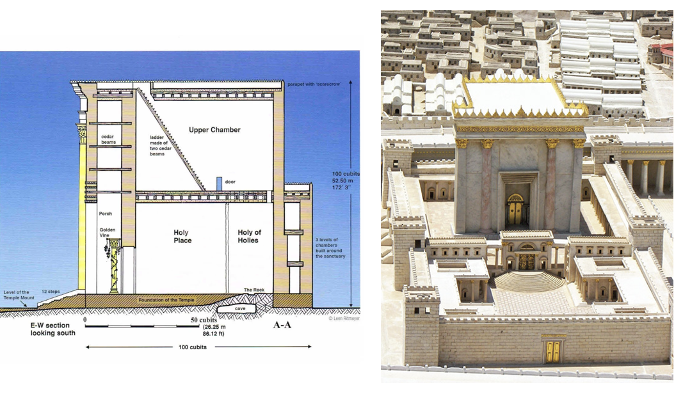
Herod's Temple, 19 BCE-70 CE, Jerusalem.
So what?
Massive
reconstructed
Veil super thick - 4-5 inches thick
Jesus would’ve worshipped at this temple
Loss of the molten sea - 12 oxen
roman style temple (architecture)
no Ark of the covenant
Built on the temple mount
bright - white and gold
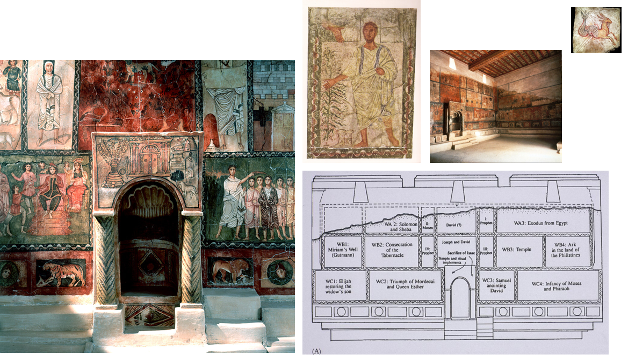
Interior of the synagogue with biblical wall paintings, Dura-Europos, Syria, ca. 245–256 CE.
So what?
Oldest church building
Moses and other biblical figures on the walls
at the burning bush - hand of God (frescos - Roman style)
Images disputed the idea that jews rejected art
Zodiac signs on the ceiling
Manu dei
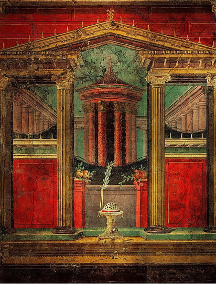
Second Style wall paintings, from the Villa of Publius Fannius Synistor, Boscoreale, Italy, ca. 50–40 bce.
So what?
perspective
illusionism
window into the outside world
landscapes, city scapes
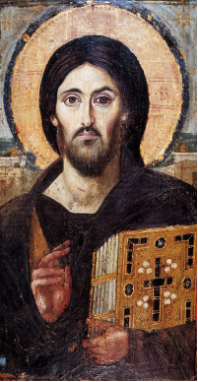
Christ blessing, Mount Sinai, 6th century CE.
So what?
duality of Christ - justice and mercy
They (Byzantians) knew the rules of naturalism and chose to break them
This image is split into four sections by a cross
shows that there wasn’t a common agreement on what Jesus looks like
four sections
Skin red (alive)
Skin white (dead)
Near, far
justice and mercy
About perceptual transformation: when you approach Christ, different people will have different visual experiences.
Found out in the desert in the Sinai wilderness

The Lycurgus Cup, 4th century CE, Roman, The British Museum, London.
So what?
Metamorphosis and transfiguration
green-red transformation when exposed to light, like grapes changing
Nymph turning into vines as you turn the cup - story of Dionysus
Lycurgus chased after the nymph, turns into vines
Reminiscent of suffering and Laocoon and his sons
Gold and silver nano particles
Inside of the cup - Lycurgus looks bloody
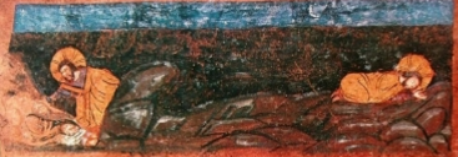
Rossano Gospels, 6th century CE, Greek, Byzantine, now at Diocesan Museum, Rossano Cathedral.
So what?
painted on lamb’s skin, dyed a red color (reminiscent of Christ’s sacrifice through the materials)
example of materiality
Gethsemane previously omitted from art, this is the first depiction of Gethsemane
Usually did not depict Christ suffering in early Christianity
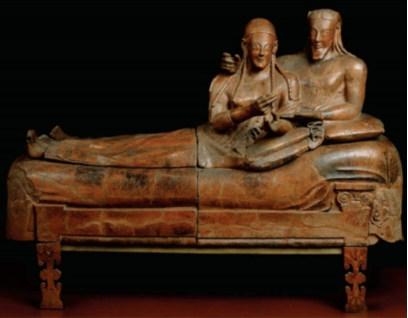
Sarcophagus with reclining couple, Cerveteri, Italy, ca. 520 bce.
So what?
believe in eternal marriage, depicted in funeral art
Etruscan (believed in multiple gods)
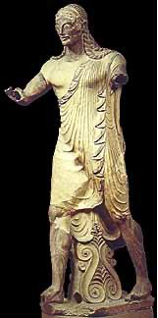
Apulu, from the roof of the Portonaccio temple, Veii, Italy, ca. 510-500 BC.
So what?
Etruscan
On roof of temple as opposed to Greeks, who put sacred objects inside the temple
Made of terracotta as opposed to marble (greek)
Highly reflective and captured sunlight

Interior of the Tomb of the Leopards, Monterozzi necropolis, Tarquinia, Italy, ca. 480 BC.
So what?
etruscan
composite view
iconic style
Heavens are filled with gemstones
polychrome squares evoke heaven

Still life with peaches from the House of the Stags, Herculaneum, Italy, 62-79 AD.
So what?
Romans invented the still life
Still life: close-up of an inanimate object
Fourth style (a bit of everything)
Visual analogy: consumption / momento mori (reminder of death)

Equestrian Statue of Marcus Aurelius, from Rome, Italy, 175 AD.
So What?
merciful - clemency
offering mercy to enemies
disproportionate in size - hierarchy of scale
too big for the horse
Symbolic style
hyperrealistic
Not destroyed because people thought it was Emperor Constantine
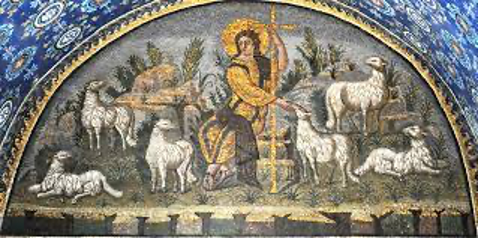
Christ as a Good Shepherd, mosaic from the entrance wall of the Mausoleum of Galla Placidia, Ravenna, Italy, 425 AD.
So what?
mosaid - tiny glass shards (tesserae)
Christ is effeminate - has feminine features, beardless
all created in God’s image
One of the first depictions of the cross
Iconic style
Light coming through the windows would reflect off halo
Phenomenology
Mosaics on walls and vaulted ceiling
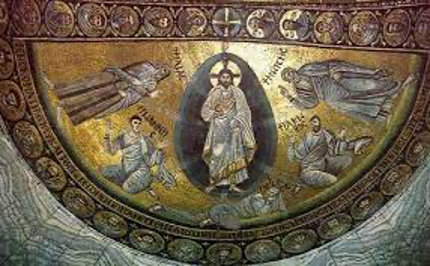
Transfiguration, mosaic in the apse of the Church of the Virgin, monastery of St. Catherine, Mount Sinai, Egypt, 548-565 AD.
So what?
This image changed the history of art to the modern day
Depicts Jesus surrounded by Peter, James, and John. Moses & Elias hovering in the air —This formula is seen in multiple depictions of the transfiguration
The entire mosaic, down to the eucharist, is depicting metamorphosis
In the shape of an eye, visionary state of discernment
More abstract and flat than Greco or Roman Art.
Iconic, symbolic
Byzantine Style
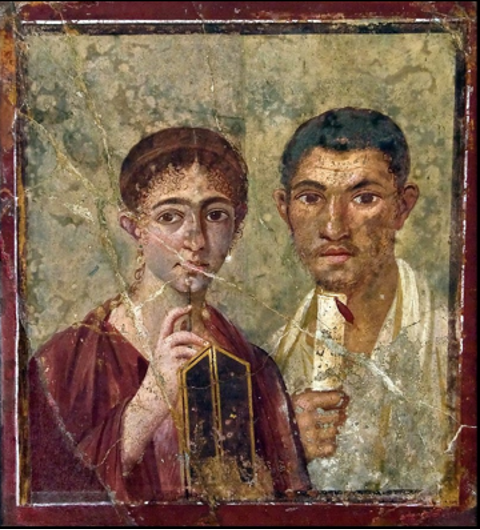
The baker Terentius Neo and his wife, mural painting from house VII, Pompeii, ca. 70–79AD.
So what?
Verism
painting of a painting because she has put makeup on her face
Shows the process of creativity - she is in the process of thinking and is ready to create something
Roman beauty standards
female is an intellectual, on the same level of the male
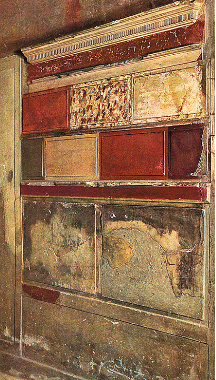
First Style mural painting Samnite House, Herculaneum, late second century BCE.
so what?
first style - imitated masonry
Colors and patterns that look like marble
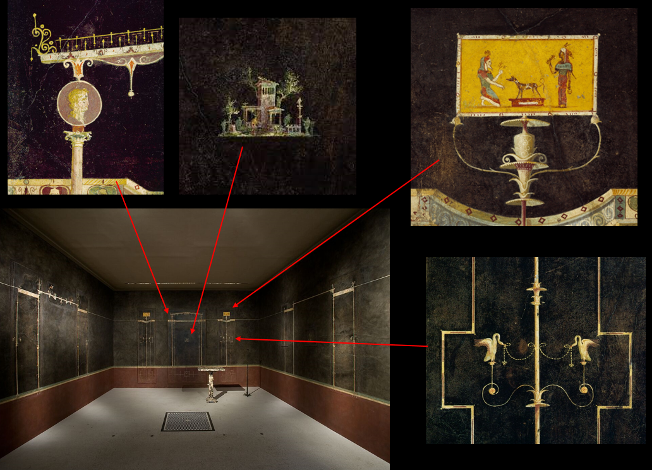
Third Style mural painting, from the Black room, Villa of Agrippa Postumos, Boscaetrucase, 10 BCE
So what?
third style - monochromatic scheme with tiny details, often whimsical or depicting divine element
against doubt - have to look closely

Fourth Style mural paintings, Myths of Penthus, Hercules, and Dirce, House of the Vettii, Pompeii, ca. 62–79 CE.
So what?
fourth style - a little bit of everything
Pentheus - don’t persecute the wine god, women sent by Dionysus to chase Pentheus and ripped him apart because they thought he was a boar
Warning against intoxication
One of the only myths quoted by Jesus in the Bible
Depictions are within the context of the others
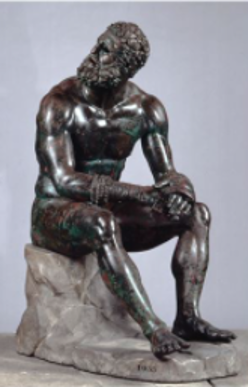
Seated boxer, Rome, Italy, ca. 100–50 bce
So what?
veristic
super beat up
older man
Cauliflower ears from boxing
Stoicism
lost his fight, looking up towards the sky, contemplative
Debated if its Hellenistic or just pure realism
transition period between style
Transition from religion to philosophy
don’t know if hes praying or just thinking